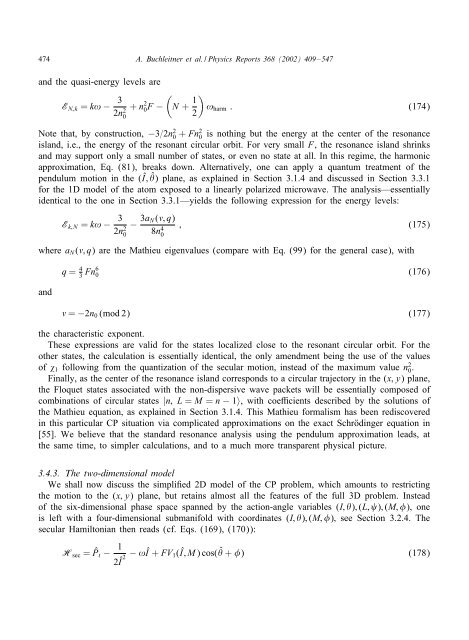Non-dispersive wave packets in periodically driven quantum systems
Non-dispersive wave packets in periodically driven quantum systems
Non-dispersive wave packets in periodically driven quantum systems
You also want an ePaper? Increase the reach of your titles
YUMPU automatically turns print PDFs into web optimized ePapers that Google loves.
474 A. Buchleitner et al. / Physics Reports 368 (2002) 409–547<br />
and the quasi-energy levels are<br />
EN;k = k! − 3<br />
2n2 + n<br />
0<br />
2 0F −<br />
<br />
N + 1<br />
<br />
!harm : (174)<br />
2<br />
Note that, by construction, −3=2n2 0 + Fn20 is noth<strong>in</strong>g but the energy at the center of the resonance<br />
island, i.e., the energy of the resonant circular orbit. For very small F, the resonance island shr<strong>in</strong>ks<br />
and may support only a small number of states, or even no state at all. In this regime, the harmonic<br />
approximation, Eq. (81), breaks down. Alternatively, one can apply a <strong>quantum</strong> treatment of the<br />
pendulum motion <strong>in</strong> the (Î; ˆ ) plane, as expla<strong>in</strong>ed <strong>in</strong> Section 3.1.4 and discussed <strong>in</strong> Section 3.3.1<br />
for the 1D model of the atom exposed to a l<strong>in</strong>early polarized micro<strong>wave</strong>. The analysis—essentially<br />
identical to the one <strong>in</strong> Section 3.3.1—yields the follow<strong>in</strong>g expression for the energy levels:<br />
Ek;N = k! − 3<br />
2n2 −<br />
0<br />
3aN ( ; q)<br />
8n4 0<br />
; (175)<br />
where aN ( ; q) are the Mathieu eigenvalues (compare with Eq. (99) for the general case), with<br />
and<br />
q = 4<br />
3 Fn6 0<br />
(176)<br />
= −2n0 (mod 2) (177)<br />
the characteristic exponent.<br />
These expressions are valid for the states localized close to the resonant circular orbit. For the<br />
other states, the calculation is essentially identical, the only amendment be<strong>in</strong>g the use of the values<br />
of 1 follow<strong>in</strong>g from the quantization of the secular motion, <strong>in</strong>stead of the maximum value n 2 0 .<br />
F<strong>in</strong>ally, as the center of the resonance island corresponds to a circular trajectory <strong>in</strong> the (x; y) plane,<br />
the Floquet states associated with the non-<strong>dispersive</strong> <strong>wave</strong> <strong>packets</strong> will be essentially composed of<br />
comb<strong>in</strong>ations of circular states |n; L = M = n − 1〉, with coe cients described by the solutions of<br />
the Mathieu equation, as expla<strong>in</strong>ed <strong>in</strong> Section 3.1.4. This Mathieu formalism has been rediscovered<br />
<strong>in</strong> this particular CP situation via complicated approximations on the exact Schrod<strong>in</strong>ger equation <strong>in</strong><br />
[55]. We believe that the standard resonance analysis us<strong>in</strong>g the pendulum approximation leads, at<br />
the same time, to simpler calculations, and to a much more transparent physical picture.<br />
3.4.3. The two-dimensional model<br />
We shall now discuss the simpli ed 2D model of the CP problem, which amounts to restrict<strong>in</strong>g<br />
the motion to the (x; y) plane, but reta<strong>in</strong>s almost all the features of the full 3D problem. Instead<br />
of the six-dimensional phase space spanned by the action-angle variables (I; ); (L; ); (M; ), one<br />
is left with a four-dimensional submanifold with coord<strong>in</strong>ates (I; ); (M;<br />
secular Hamiltonian then reads (cf. Eqs. (169), (170)):<br />
); see Section 3.2.4. The<br />
Hsec = ˆPt − 1<br />
2Î 2 − !Î + FV1(Î;M) cos( ˆ + ) (178)











